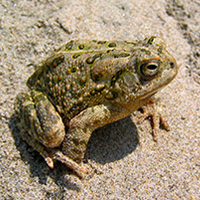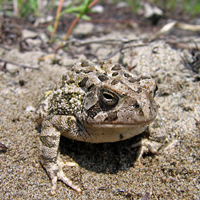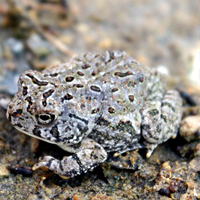Fowler’s toad
Scientific name: Anaxyrus fowleri



Cover photos credit: Scott Gillingwater (left), Sam Brinker (middle), and Rob Tervo (right)
Status
Endangered
“Endangered” means the species lives in the wild in Ontario but is facing imminent extinction or extirpation.
Date added to the Species at Risk in Ontario List
The Fowler’s Toad was listed as threatened when the Endangered Species Act took effect in 2008, and was re-assessed as endangered on September 28, 2010.
Read the Assessment Report
What it looks like
Fowler’s Toad is a grey to beige-coloured medium-sized toad with numerous dark brown spots and warts on its textured skin. They typically have white to cream coloured bellies. The throat of the males is dark while it is white on the females.
Fowler’s Toads have a distinctive call that is sometimes described as a prolonged shrill or a “muffled scream from a distressed sheep".
Where it lives
In Ontario, Fowler’s Toads inhabit open beaches, dunes, sandy shorelines, rocky pools, creek and stream mouths, backshore wetlands, and marshes along the northern shore of Lake Erie.
Where it’s been found in Ontario
Fowler’s Toad is found throughout much of eastern North America, from the Gulf Coast north to the Great Lakes. In Canada, Fowler’s Toad is restricted to only three localities: Rondeau, Long Point and Niagara.
View a Larger version of this map (PDF)
What threatens it
The main threat to Fowler’s Toads is habitat loss and degradation. The loss and degradation of dunes, beaches, and wetlands as a result of shoreline development and recreation use, reduces areas for breeding, hiding, burrowing, and hibernating.
Storm water runoff from urban, agricultural and industrial areas results in poor water quality in breeding and tadpole nursery areas and affects the survival of Fowler’s Toads.
Action we are taking
Endangered Species and their general habitat are automatically protected
Recovery strategy
A recovery strategy advises the ministry on ways to ensure healthy numbers of the species return to Ontario.
Executive Summary (February 18, 2011)
Full Document (February 18, 2011)
Government response statement
A government response statement outlines the actions the government intends to take or support to help recover the species.
Read the government response statement (November 18, 2011)
Five-Year Review of Progress
A five-year review reports on progress made toward protecting and recovering a species, within five years of publishing a species’ government response statement.
Read the report on progress towards the protection and recovery of 27 species at risk, including Fowler’s Toad (2016)
Habitat protection
A habitat regulation defines a species' habitat and many describe features (e.g. a creek, cliff, or beach), geographic boundaries or other unique characteristics.
Read the habitat summary (January 1, 2014)
Read the regulation (January 1, 2014)
What you can do
Report a sighting
- Report a sighting of an endangered animal or plant to the Natural Heritage Information Centre. Photographs with specific locations or mapping coordinates are always helpful.
- Submit your observations at iNaturalist
Volunteer
- Volunteer with your local nature club or provincial park to participate in surveys or stewardship work focused on species at risk.
Be a good steward
- Private land owners have a very important role to play in species recovery. If you find Fowler’s Toad on your land, you may be eligible for stewardship programs that support the protection and recovery of species at risk and their habitats.
Report illegal activity
- Report any illegal activity related to plants and wildlife to
1-877-TIP-SMNR (847-7667) .
Quick facts
- Fowler’s Toads breed in mid-to-late spring in sandy bottom ponds, stream and creek mouths, shallow near shore areas, and rocky pools. Eggs hatch in about seven days and tadpoles develop in these habitats for 40 to 60 days, after which they undergo a metamorphosis and emerge onto beaches as "toadlets" which are less than ten millimetres in size.
- Fowler’s Toads are nocturnal and are mostly active at night, but can occasionally be seen during rainy overcast days.
- Fowler’s Toads come to the water’s edge of the beach at night to feed, to cool off and absorb water.
- Juvenile and adult Fowler’s Toads hibernate below the frost line and just above the water table in sand dunes during the fall and winter months. During the active season they take refuge in dunes and sandy beaches to conserve water, keep cool and to avoid predation.
- Snakes such as the Common Garter Snake and the Eastern Hog-nosed Snake are the main predators of toads. However, raccoons, bullfrogs, fish and some birds are also known to prey upon toads.
- The skin of a Fowler’s toad has a distinct odour of unroasted peanuts.
